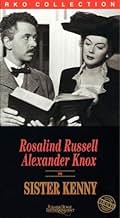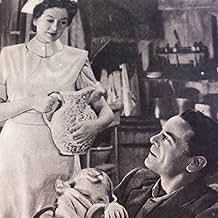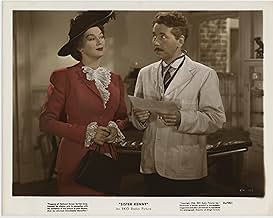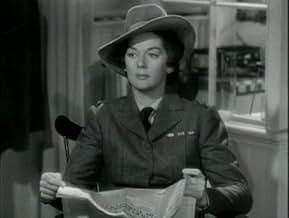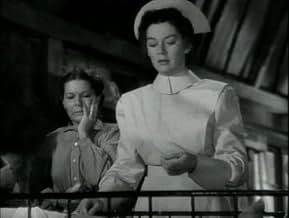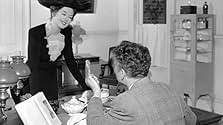An Australian nurse, Sister Kenny, discovers an effective new treatment for infantile paralysis, but experiences great difficulty in convincing doctors of the validity of her claims.An Australian nurse, Sister Kenny, discovers an effective new treatment for infantile paralysis, but experiences great difficulty in convincing doctors of the validity of her claims.An Australian nurse, Sister Kenny, discovers an effective new treatment for infantile paralysis, but experiences great difficulty in convincing doctors of the validity of her claims.
- Nominated for 1 Oscar
- 4 wins & 2 nominations total
- Undetermined Minor Role
- (scenes deleted)
- Boy
- (scenes deleted)
- Minor Role
- (uncredited)
- Doctor
- (uncredited)
- Mr. Ferguson
- (uncredited)
- Doctor
- (uncredited)
- Doctor
- (uncredited)
Featured reviews
The film chronicles the personal sacrifices Kenny made, giving up a chance at marriage, in order to help the children she encountered with polio and to try to convince the medical profession that her treatment was viable.
Rosalind Russell, whose nephew was helped by the Kenny Method, plays Sister Kenny, and she's wonderful. She ages during the film, but it's more than gray hair and some shadows drawn on the face - the age is in her walk, her attitude, and her carriage. A fantastic job that earned her an Oscar nomination.
Actor Alan Alda, opera star Marjorie Lawrence, and "Li'l Abner" creator Al Capp all were treated with the Kenny Method. Though the medical profession attempts to blow off alternative treatments, I've seen them work. This film is a reminder of the wall they put up, and one person's determination to break through it.
But no. Sister Kenny, knowing nothing about infantile paralysis, begins fiddling around with it in the Australian outback and develops a theory that is, in some senses, the exact opposite of the medical establishment's. That establishment is really "pig-headed", as she puts it. Well, they have to be, actually. The experts and their received wisdom can't be successfully challenged by a mere mortal. If they were, they wouldn't be "experts" anymore. She's successful, of course, or there would be no movie. All this takes place during the first half of the 20th century and has Sister Kenny traveling from Australia to Europe and to Minnesota. Old friends die. Children are apparently cured.
There are a couple of things that lift the film out of the ordinary biopic genre. One is Rosalind Russel's performance and the way her role is written by Dudley Nichols. She's impertinent and sarcastic. In fact she reminded me a lot of Margaret Mead, acerbic and distant, putting family life second to her career. Russel has never been better in what is a fairly demanding role.
Another point in its favor is that we are mercifully spared the sobbing and the dying and the children begging for help from a mothering figure. Russel is hardly maternal. Multiple opportunities for pointless and sentimental scenes were eschewed. Her humanity is on display in abundance but it's in code.
Nice job.
The film opens with Elizabeth Kenny (Rosalind Russell) graduating from nursing school in Australia and returning home to the bush to celebrate with her parents along with her mentor, Dr. McDonnell (Alexander Knox). She there informs them she intends to be a rural nurse, basically a circuit rider nurse, who goes among the sparsely distributed rural population where she is needed. Like most women of the early 20th century, she intends her career to end when she marries her beau, Kevin (Dean Jagger).
Then one day Kenny is called to a house where the little girl is ill with horribly debilitating muscular spasms. She has no idea what is wrong, so she telegraphs Dr. McDonnell who says it is infantile paralysis (polio) and to treat the symptoms because nothing else can be done. So using her knowledge of biology and knowing nothing of the disease, she does just that. When the crisis passes and the girl cannot move her legs, Kenny studies the situation a bit and figures that the girl needs to relearn how to walk. The girl does walk normally again. She has five more cases that she treats the same way and all fully recover.
Kenny is angry that the doctors stodgily hold to the traditional treatment and refuse to give her treatment a second thought. They also forbid her to treat any more acute cases in this way. So she takes the crippled children the doctors have given up on and has marvelous success.
Needless to say this delays her marriage to Kevin to the point where she finally breaks it off with him for his sake. The years turn to decades, she eventually comes to America, and although the medical establishment never gives her treatments any credence, the young up and coming doctors are anxious to learn about her method because she is getting results.
All through the film much is said about how she always wanted ten children, but figured she would always hear the suffering of polio stricken children every time hers laughed, and resigned herself to being unmarried and childless. The final scene insinuates that she might not be so childless as she thinks.
The movie was a passion project for Russell, who worked with the Sister Kenny Foundation, and it shows through in the authenticity of her portrayal. Russell was well aware that biopics about cause crusaders were usually not cash cows, but she felt it was a film she really needed to do, although none of the studios initially showed any interest. She finally agreed to a three-picture deal with RKO if one of those pictures could be Sister Kenny.
Did you know
- TriviaThe Wikipedia article on Elizabeth Kenny lists notable individuals who had been polio patients of Sister Kenny. Among those listed are Alan Alda, Dinah Shore, and Rosalind Russell's nephew. It is known that Rosalind Russell had long campaigned to portray Sister Kenny on film; her nephew's treatment might have been a factor in that interest.
- GoofsAlthough mostly set in Australia with primarily Australian characters, nobody in the cast attempts to speak in anything other than each's own native accent.
- Quotes
Dr. McDonnell: Whatever you do, whatever happens, remember the people are more important than the system. That's true in government, they're fighting a war to prove it. And it's true in medicine. You've got that fight left Elizabeth. It's a big fight, it wont be easy, I wish I could help you.
- SoundtracksIt's a Long Way to Tipperary
(1912) (uncredited)
Written by Jack Judge and Harry Williams
Sung offscreen by a chorus of men
- How long is Sister Kenny?Powered by Alexa
Details
Box office
- Budget
- $1,200,000 (estimated)
- Runtime1 hour 56 minutes
- Color
- Aspect ratio
- 1.37 : 1
Contribute to this page


